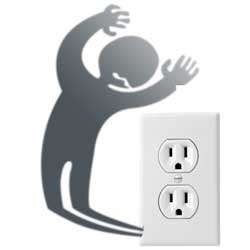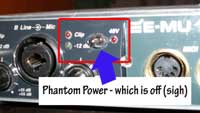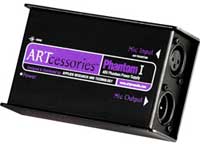What Is Phantom Power Really?

Recently I posted something called Phantom Power – A Dizzying Description in which I called attention to the fact that audio recording terms like phantom power are often hard to describe if you try to get into the details.
I had asked someone to put together a 400-word essay on it for me and was stunned with how academic (to put it euphemistically) it came across. My eyes glazed over halfway through.
I went ahead and posted those 400 words for those who are more academically and technically inclined, but promised a now-what-is-it-really-and-only-tell-me-what-I-need-to-know post on phantom power very soon afterward. This is that post.
Okay, so to cut right to the chase – there are basically 2 types of microphones, dynamic and condenser. Ribbon mics are sometimes called a 3rd category but really are a variant of the dynamic.
What you need to know:
Dynamic mics don’t need electric power.
Assuming the thing you plug them into – a mixer or PA of some sort – is plugged in, all you have to do is poke the microphone cable from a dynamic mic into a mixer and you’re good to go. That type of mic works by the sound coming into it (your lovely voice, perhaps) physically moving the parts (magnet and wire coil) inside. Those movements are then converted to an audio signal.
Condenser mics DO require electricity
Condenser mics need more power than what a plain old mixer or audio interfaces can provide. That’s because condenser mics convert air movement (caused by your lovely voice) to audio in a different way (changing capacitance if you must know, which you don’t;)). That different way needs about 48 volts of DC voltage electricity just for the mic to work.
As you may have guessed by now, that 48 volts of extra juice is called phantom power, probably because it comes into the mic not via the way you power up most things, namely with a plug of some sort.
Phantom power comes into the mic through a mixer or interface by flipping a switch on the mixer. Sometimes the switch is labeled. But often you’ll just see “48V” or something similar on the device, usually next to a switch and an indicator light (so you know if it’s on or off).

It is not at all uncommon (meaning I do this all the time!!) to plug the condenser mic in and get all ready to record only to find there is no sound coming through the mic because someone (me) forgot to turn on phantom power. You have been warned.
One other thing you should know. It is possible to carry your own phantom power, which is handy if you are a musician doing gigs. This just happened to me a few months ago.
I was at a venue that used a condenser microphone on-stage. Their amp died and the owner came back with a combo mixer/amplifier thing that is very useful for live PA stuff. But since for live PA stuff, most people use dynamic mics, there was no phantom power on the mixer. We couldn’t use it for the venue.
But a musician friend of mine had a portable phantom power unit similar to the ART Phantom I unit pictured on the left. All you need then is an outlet and an extra mic cable. We just plugged the condenser mic into the ART, then plugged the extra mic cable into the output of the ART and into the mixer. Voila! Phantom power. The day was saved.
So that is all you really need to know about phantom power. Condenser mics need it. Dynamic mics don’t. If you are all set up to record (or play live) with your condenser mic and you are getting no sound, chances are good that you forgot to turn on the phantom power.


So, I was going to respond by saying, “Be sure to never connect a ribbon mic to a powered input.” But then I thought I’d be sure I knew what I was talking about before posting, and sure enough, I came up with this article – https://recordinghacks.com/2008/04/02/phantom-power-kills-ribbon-microphones-truth-vs-fiction/. Found it very interesting.
Awesome Gregory. Thanks for that! I’m a big fan of separating fact from fiction and this does that very well. For others reading this, it is a myth (mostly) that phantom power will destroy your ribbon mics. Basically it boils down to whether you use a patch bay in your home recording studio, and whether you run mics through it. If you don’t and you don’t, then do not worry about phantom power killing your ribbon mic:).
I have a new Mic from ReverbPro: It says to push the phantom switch to get it to sound. There is no phantom switch on it and the computer says it is ready but the Mic pg. shows “three high definition Mics” the bottom one says “not connected.” I don’t know what to do about connecting it. Any advice?
Hi Dena. Can you tell me what brand and model the mic is?